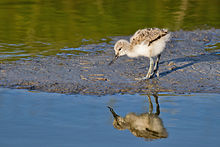
Pied Avocet
Did you know...
SOS Children have produced a selection of wikipedia articles for schools since 2005. See http://www.soschildren.org/sponsor-a-child to find out about child sponsorship.
| Pied Avocet | |
|---|---|
 |
|
| Conservation status | |
 Least Concern ( IUCN 3.1) |
|
| Scientific classification | |
| Kingdom: | Animalia |
| Phylum: | Chordata |
| Class: | Aves |
| Order: | Charadriiformes |
| Family: | Recurvirostridae |
| Genus: | Recurvirostra |
| Species: | R. avosetta |
| Binomial name | |
| Recurvirostra avosetta Linnaeus, 1758 |
|
The Pied Avocet, Recurvirostra avosetta, is a large black and white wader in the avocet and stilt family, Recurvirostridae. They breed in temperate Europe and western and Central Asia. It is a migratory species and most winter in Africa or southern Asia. Some remain to winter in the mildest parts of their range, for example in southern Spain and southern England.
This species gets its English and scientific names from the Venetian name avosetta. It appeared first in Aldrovandi's Ornithologia (1603). While the name may refer to black and white outfits once worn by European advocates or lawyers, the actual etymology is unknown. Other common names include Black-capped Avocet, Eurasian Avocet or just Avocet.
The Pied Avocet is one of the species to which the Agreement on the Conservation of African-Eurasian Migratory Waterbirds ( AEWA) applies.
Description
The Pied Avocet is a striking white wader with bold black markings. Adults have white plumage except for a black cap and black patches in the wings and on the back. They have long, upturned bills and long, bluish legs. It is approximately 16.5–17.75 inches (42–45.1 cm) in length of which the bill is approximately 2.95–3.35 inches (7.5–8.5 cm) and the legs are approximately 3–4 inches (7.6–10 cm). Its wing-span is approximately 30–31.5 inches (76–80 cm). Males and females look alike. The juvenile resembles the adult but with more greyish and sepia tones.
The call of the Avocet is a far-carrying, liquid, melodious kluit kluit.
Behaviour
These birds forage in shallow brackish water or on mud flats, often scything their bills from side to side in water (a feeding technique that is unique to the avocets). They mainly eat crustaceans and insects.
Their breeding habitat is shallow lakes with brackish water and exposed bare mud. They nest on open ground, often in small groups, sometimes with other waders. 3-5 eggs are laid in a lined scrape or on a mound of vegetation.
In Britain
The Avocet became extinct in Great Britain in 1840. Its successful recolonisation at Minsmere, Suffolk, in 1947 led to its adoption as the logo of the Royal Society for the Protection of Birds.

